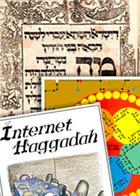Haggadah

It is hard to think of another classic Jewish text reprinted, rewritten, and re-imagined as often, or as divergently, as the Haggadah. The Passover Seder is the most ubiquitous Jewish observance—fully three-quarters of American Jews participate in a Seder of some kind, as do 80–95 percent of Israelis. The abundance of Haggadot, in other words, reflects the ubiquity of the observance.
Of course, the Haggadah has long been a mirror of Jewish history. Once its text had stabilized by the dawn of the Middle Ages, it became the object of lavish and continuing attention on the part of commentators, illuminators, illustrators, and translators. The advent of printing made it even more available and even more open to interpretation. Because the basic text and structure have remained more or less in place, the many versions offer snapshots of their times and places.
Today that historical diversity is in overdrive. The number of new Haggadot produced every year is overwhelming. Even more dazzling, or dizzying, is the range of perspectives they exhibit: rabbinic, academic, New Age, feminist, ecological, neo-Hasidic, and on and on.
Through the Haggadah and the Seder, wrote the late Yosef Hayim Yerushalmi, "the memory of the nation is annually revived and replenished, and the collective hope sustained." Yet precisely that sense of the collective, not to mention its celebration, seems absent from many of today's Haggadot, even the best of them. Instead, the journey of Passover is increasingly, intensely, presented as personal and subjective. Here again the Haggadah serves as a mirror of the times.
If today's radically diverse Haggadot seem to strain Jewish collectivity to the breaking point, will tomorrow's witness a rebound? There are grounds for hoping so, provided the shared center holds: the calendar, the set of practices, and the old text itself, read, interpreted, reinterpreted, and then read—and sung—once again.
Comments are closed for this article.





May you have a good pesach